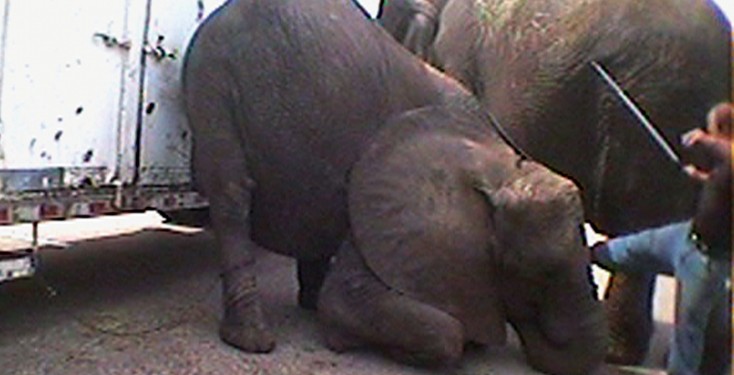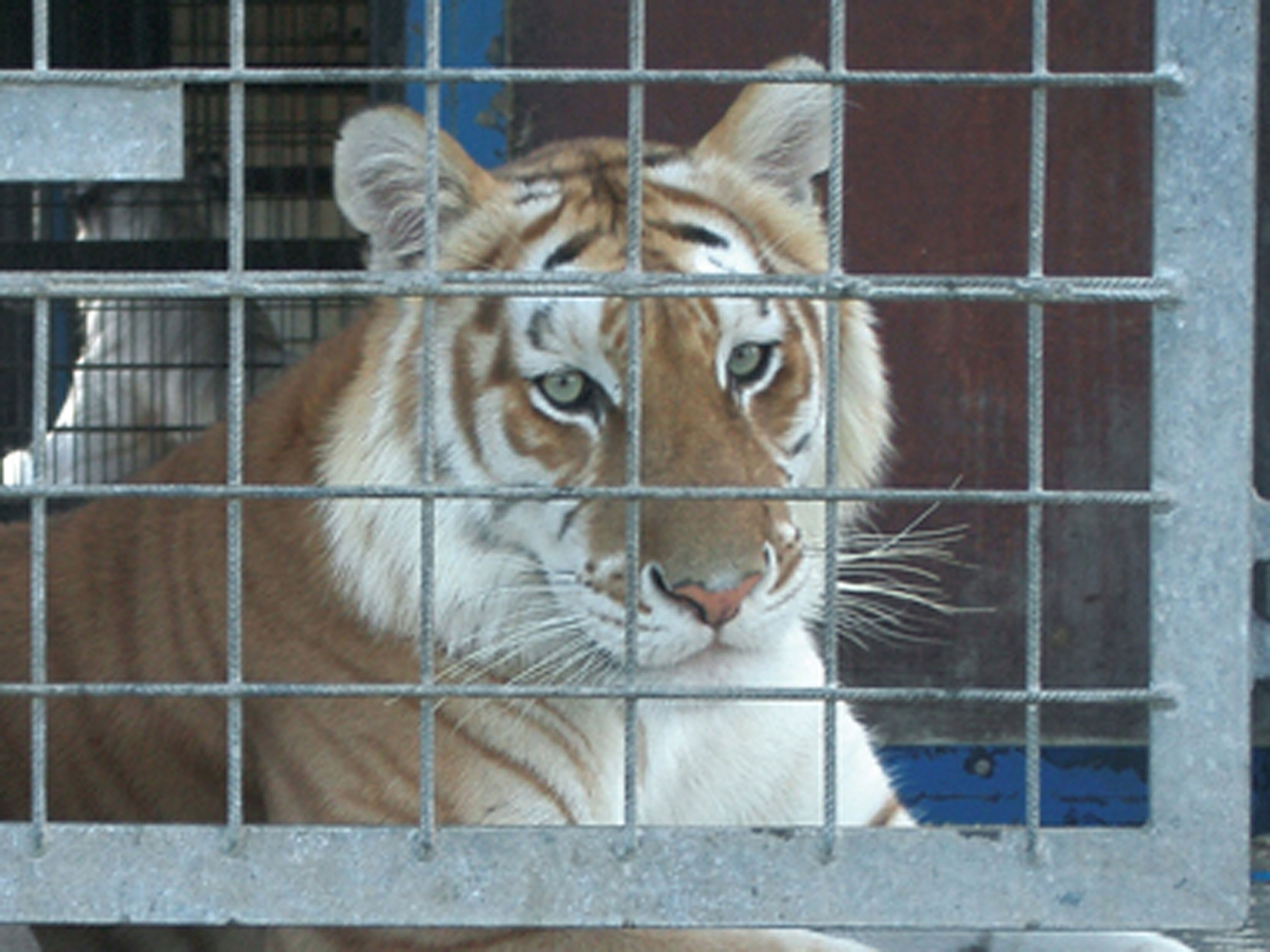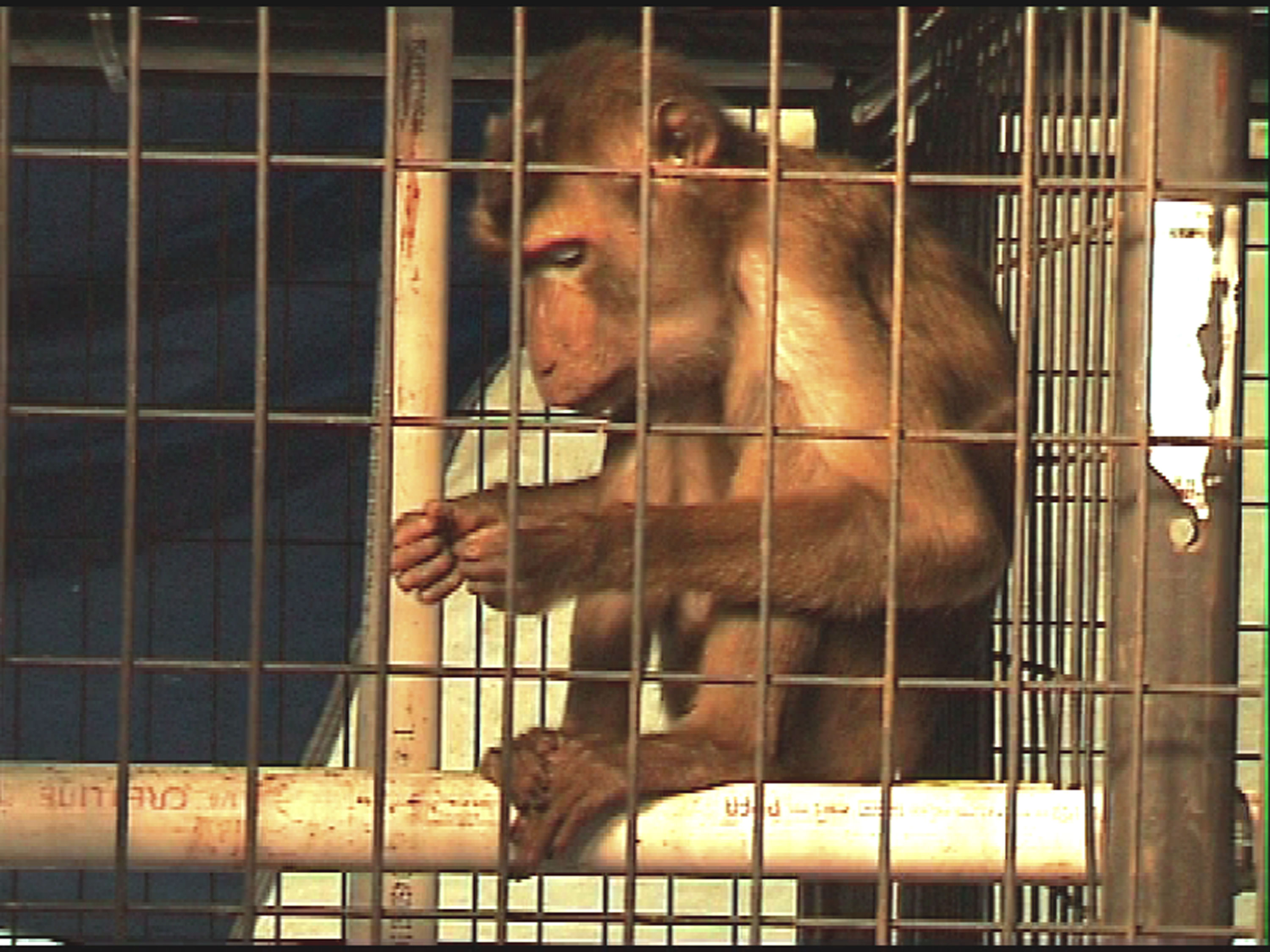Suffering in US Circuses Exposed
An ADI investigation of the US circus industry has exposed confinement, deprivation, lax safety standards and cases of severe violence to animals.

An ADI investigation of the US circus industry has exposed confinement, deprivation, lax safety standards and cases of severe violence to animals.
(Pictured above: Mike Swain with Bailey Bros. Circus kicking an elephant)
We have exposed sickening violence inflicted on two female elephants, Krissy and Boo, who were electric shocked during training sessions and when being moved to the ring to perform. Krissy was beaten, dragged to the ground and kicked in the face.
We found that all circuses observed shared common traits in regards to the confinement and environmental deprivation of the animals. The results of the investigation have been collated in a scientific report: Animals in Traveling Circuses: The Science on Suffering and the DVD Stop Circus Suffering.
An ADI Field Officer worked undercover inside Bailey Brothers Circus as it toured Texas, Oklahoma, Illinois and Missouri and filmed horrific brutality. An ADI team also monitored and filmed inside eight other circuses – Hanneford Family Circus, Circus Royale, Sterling and Reid Circus, Circus World in Wisconsin, Clyde Beatty Cole Brothers Circus, Ringling Brothers and Barnum and Bailey Circus, Shrine Circus and UniverSoul Circus. In total these circuses used over three hundred animals between them including 31 elephants, 36 tigers, leopards, lions, monkeys, zebras, dogs, cats, horses and donkeys.
Elephants chained, beaten, shocked and kicked.
At Bailey Brothers Circus, Krissy, a 20-year-old African elephant belonging to Billy Swain, and Boo, a 35-year-old Asian elephant belonging to Mike Swain, spent some entire days permanently chained by the legs and barely able to move. Generally, each night, the elephants were chained inside their trailer at 9.30pm and left there for up to thirteen hours. At best, they would be loose inside a tiny, electric-fenced, concrete enclosure during the day but, Krissy especially, would often be chained by the leg to the trailer.
Trips to events and shows to give rides would result in even more confinement. On one occasion Krissy and Boo left their trailer for just six hours in a 72 hour period – as they moved to and from a Hindu Festival to give rides – and were forced to relieve themselves where they stood chained in their trailer. When they finally returned to the circus they were let out, but poor Krissy was immediately chained up outside.
Little wonder these poor animals displayed disturbing stereotypic behaviour including swaying and head-bobbing. Krissy would eat rubbish, including plastic and paper bags, threw rubbish at people and would regularly try to escape.
This wretched existence was punctuated with violence. In our Stop Circus Sufferingvideo you see Mike Swain viciously hitting Krissy across the face, dragging her to her knees with a sharp bullhook and kicking her face (watch the video above). These bullhooks, also known as elephant hooks or ankuses, were ubiquitous to the circuses we monitored.
Swain also used a golf club to strike the elephants and an electric shock device during training sessions and whilst moving the animals to the ring to perform. Our evidence has been sent to the USDA which is currently investigating.
US circus elephants: A life restrained.
Elephants are designed to travel long distances each day, browse a variety of plants and have a highly developed social structure. The difficulties of containing large, powerful and potentially dangerous animals in temporary or improvised accommodations has a severe impact on their welfare. The circus routine is to chain elephants overnight by a front and hind leg, severely restricting movement to a pace or two backwards and forwards.
This period generally lasts from when the animals finish their last performance to the next morning, often 12 hours. During the day, when not performing, giving rides or posing for photos, the most common practice is to enclose the elephants inside a small electric-fenced area. This can be on asphalt, concrete or grass.
During two days of observations at Circus UniverSoul in Michigan, an African and an Asian elephant were kept permanently chained when not performing.
Optimum accommodation at Clyde Beatty Cole Brothers Circus, Atlanta, Georgia, Circus Royale, New York State, Shrine Circus, Minnesota, and Ringling Brothers Barnum and Bailey Circus in Los Angeles was a small electric-fenced enclosure which the animals could cross in a few paces, with little or no environmental enrichment or stimulation.
Horses, ponies, camels and llamas.
Horses and other hoofed animals don’t fare much better. Horses, ponies, camels, llamas and similar animals usually spend their days tied up by short ropes or kept in small stalls. The ADI Field Officer at Bailey Brothers Circus documented seven small Shetland ponies and a white horse who were generally tied to a six-foot rope attached to a stake or a picket line (running line staked to the ground) without shelter during the day. Otherwise, they were confined to a small pen.
One day, the pony ride attendant reported that the ponies didn’t get enough rest, since they must work the carousel for five continuous hours. One pony had a swollen eye. Another kept trying to get down on her knees. A third had a breathing problem and was hyperventilating and gagging.
The white horse, Snowy, had cuts and sores which were attracting flies so a circus worker used Clorox bleach on the open cuts.
Tigers on trucks.

For tigers and lions in circuses, home is usually a cage on the back of a truck – around 8ft wide by 40ft long. The average space for each animal is barely larger than the animal itself, which includes space to defecate. Such living quarters were filmed at Clyde Beatty Cole Brothers and UniverSoul Circus. At Shrine Circus in Minnesota, tigers were also kept for extended periods in very small wheeled cages that are usually used to take them to and from the ring to perform.
At Sterling and Reid Circus in Virginia, a three-month-old white tiger cub was living with a seven-week-old lion cub and their trainer in his trailer. It is common for circus animals to be taken away from their families, with the trainer replacing the animals’ mothers and siblings. The young tiger was used as a prop for photos during the show, further distorting the animal’s natural behaviour. This poor baby tiger, taken from his own kind at such a young age, was taken around on a lead and when he did not “behave” he was hit in the face.
Monkey tragedy.

Primates are highly intelligent, make tools, are arboreal in nature (living mostly in trees) and live in close-knit family groups. Family is important to primates. As their intelligence gives rise to the potential for escape, these animals are severely confined in traveling circuses. They are often separated from their own kind in order to reinforce dependence upon the handler as the only source of food, water, comfort and approval.
Whilst on public show in the petting zoo, two macaque monkeys with Sterling and Reid Circus were housed individually in cages 6 feet tall by 2 feet wide and deep. This is extremely small for such animals. The cages had limited enrichment, just a few toys and a perch. Overnight the animals were caged elsewhere.
Bailey Brothers Circus had four macaque monkeys and a solitary capuchin monkey which were kept in small cages inside a trailer – even if the entire trailer had been devoted to living space for these primates it is unlikely it could be made adequate. The capuchin lived in complete isolation from its own species and was occasionally moved around with a chain attached around its waist.
Public safety.
Safety is inevitably compromised when animals are kept in temporary cages and tents are dismantled on an almost weekly basis. Extreme confinement and abuse also lead to abnormal behaviour including aggression. Consequently, circus workers and members of the public are regularly at risk and there are additional dangers, such as escaped animals wandering onto roads.
At the Bailey Brothers Circus, Krissy the elephant escaped frequently, even dismantling the electric fence. She also threw stones at people with her trunk, yet, visitors were still allowed to feed her over a small barrier. Penny the zebra, at the same circus, occasionally bit members of the public and circus workers and escaped from her pen twice in four days.
We also observed elephant rides for children being given right next to tiger cages at Shrine Circus; elephants at Circus Royale in Glens Falls being walked along a public highway each day to get to and from their performance; and three elephants at Shrine Circus being left unsupervised in a small electric-fenced enclosure with no secondary fencing on the edge of a school playing field.
It is simply not possible for these travelling menageries to provide adequate accommodation for the animals and a safe family environment.
If you know someone who is considering going to a circus that features performing animals, please show them our Stop Circus Suffering DVD, and please support us so that we can keep bringing the plight of these suffering animals to light (watch this video above).
If you are interested in being a vital part of our efforts, please contact the US office at 1-800-978-ADII (2344) or send an email to usa@ad-international.org.
Find out more about Stop Circus Suffering USA
View the investigation gallery
View the launch gallery
Watch the Jorja Fox press conference
Watch us on The Geraldo Show
Read more about Remo Conscious
Read what celebrities have to say about circuses
Read The Science on Suffering Report
(The Science on Suffering: Animals in Travelling Circuses The scientific evidence and a pilot study of nine US animal circuses.)
Click for report PDF | html
Click for a Executive Summary English | Español

Cruelty ….seems its all men….perhaps they have a problem with themselves. Any man I know who is confident and a real man, does not abuse any living thing to commit to him by fear, only by love and guidance. SHAME ON YOU…you are a disgrace to all the REAL men out there. What goes round comes round, so just remember what might be round the corner you nasty little excuses for human beings.